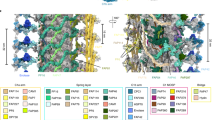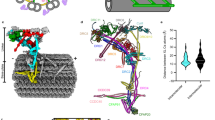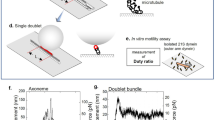Abstract
It is generally accepted that bending of a cilium is caused by active sliding between outer doublets in the cilium produced by ATP-driven activation of their dynein–tubulin cross-bridges1–3. Changes with time in the location and extent of the active sliding regions in the outer doublets are thought to be primarily responsible for the changing shape of a beating cilium. However, using conventional techniques of biochemistry and electron microscopy, it is difficult to identify the regions on the outer doublets where active sliding occurs4. Here we have used computer simulation of the beating of a cilium to investigate changes in the distribution of activated cross-bridges, and hence of active sliding, in the nine outer doublets. Hereafter, the pattern of this distribution will be termed ‘cross-bridge pattern’. Published data have indicated that there is a periodically changing series of cross-bridge patterns in the nine outer doublets. On this assumption, the computer mimicked relatively well the beating of a cilium of Paramecium in media of both normal and high viscosity. The computer also simulated flagellar-type beating5, in which the cross-bridge patterns were modified slightly.
Similar content being viewed by others
References
Satir, P. J. Cell Biol. 26, 805–834 (1965).
Satir, P. J. Cell Biol. 39, 77–94 (1968).
Summers, K. E. & Gibbons, I. R. Proc. natn. Acad. Sci. U.S.A. 68, 3092–3096 (1971).
Omoto, C. K. & Kung, C. J. Cell Biol. 87, 33–46 (1980).
Kuznizki, L., Jahn, T. L. & Fonseca, J. R. J. Protozool. 17, 16–24 (1970).
Ikeda, K., Nishihara, S., Isohama, K. & Nakayama, K. J. Inf. Processing 2, 231 (1980).
Sale, W. S. & Satir, P. Proc. natn. Acad. Sci. U.S.A. 74, 2045–2049 (1977).
Yano, Y. & Miki-Noumura, T. J. Cell Sci. 44, 169–186 (1980).
Kamimura, S. & Takahashi, K. Zool. Mag, Tokyo 88, 513 (1979).
Lindemann, C. B., Rudd, W. G. & Rikmenspoel, R. Biophys. J. 13, 437–448 (1973).
Shingyoji, C., Murakami, A. & Takahashi, K. Nature 265, 269–270 (1977).
Kuznicki, L. Acta protozool. 1, 301–312 (1963).
Naitoh, Y. Science 154, 660–662 (1966).
Eckert, R. & Naitoh, Y. J. gen. Physiol. 55, 467–483 (1970).
Gray, J. Ciliary Movement (Cambridge University Press, 1928).
Wais-Steider, J. & Satir, P. J. supramolec. Struct. 11, 339–347 (1979).
Sugino, K. & Naitoh, Y. Zool Mag, Tokyo 89, 444 (1980).
Bradfield, J. R. G. Symp. Soc. exp. Biol. 9, 306–334 (1955).
Afzelius, B. J. biophys. biochem. Cytol. 5, 269–281 (1959).
Machemer, H. Acta protozool. 11, 295–300 (1970).
Machemer, H. J. exp. Biol. 57, 239–259 (1972).
Author information
Authors and Affiliations
Rights and permissions
About this article
Cite this article
Sugino, K., Naitoh, Y. Simulated cross-bridge patterns corresponding to ciliary beating in Paramecium. Nature 295, 609–611 (1982). https://doi.org/10.1038/295609a0
Received:
Accepted:
Issue Date:
DOI: https://doi.org/10.1038/295609a0
- Springer Nature Limited
This article is cited by
-
Ciliary beating in three dimensions: Steps of a quantitative description
Journal of Mathematical Biology (1992)
-
Mechanisms of flagellar propulsion
Protoplasma (1991)





